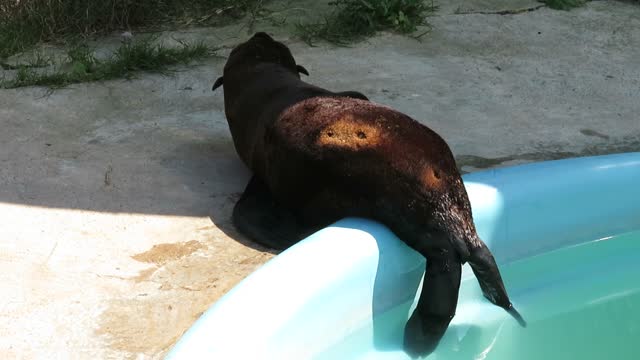Premium Only Content

Rescued Fur Seal chillin' with the tip of its flippers in the pool
This fur seal got attacked by a dog and was rescued by S.O.S Rescate de Fauna Marina, in Uruguay. He is not 100% yet, so he is still waiting for his release. Once he is fully cured and strong, he will go back to the ocean. In the meantime, he lives a carefree life, not having to worry about predators or finding food. Just like a human, he enjoys lying by the pool, with his hind flippers in the water. How adorable is that?!
Although they have "seal" in the name, Fur Seals are actually more closely related to Sea Lions than to True Seals, belonging to the Otariidae family. Otariids are also known as "eared seals". Not only do they have external ear flaps, unlike true seals (Phocids), but they also have much larger flippers and can actually walk on land, instead of galumphing, like true seals.
There are nine species of Fur Seals in the world: the Antarctic Fur Seal (Arctocephalus gazella), the Brown Fur Seal (Arctocephalus pusillus), the Galapagos Fur Seal (Arctocephalus galapagoensis), the Guadalupe Fur Seal (Arctocephalus townsendi), the Juan Fernández Fur Seal (Arctocephalus philippii), the New Zealand Fur Seal (Arctocephalus forsteri), the South American Fur Seal (Arctocephalus australis), the Subantarctic Fur Seal (Arctocephalus tropicalis), and the Northern Fur Seal (Callorhinus ursinus). As you may have noticed, the Northern Fur Seal is the only extant member of its genus, with all other Fur Seal species belonging to the Arctocephalus genus.
Allowing pets to roam around freely outdoors (as well as homeless cats and dogs) poses a huge threat to wildlife, as their instinct is to hunt/protect their territories, and attack wildlife, even though they have been domesticated. Pets are responsible for the deaths of many native animals. Please do your part in preventing more unnecessary deaths, and keep your pets on a leash when outside.
-
 0:43
0:43
NataliaCara
3 years agoIt's dinner time for this rescued immature Southern Elephant Seal
4561 -
 2:14:15
2:14:15
DLDAfterDark
3 hours ago $1.18 earnedThe AR15 BurnDown That Will Leave You Speechless!
19.4K1 -
 1:48:12
1:48:12
megimu32
4 hours agoON THE SUBJECT: Throwback Thursday | Wheel of Nostalgia Chaos!
27.1K9 -
 2:32:11
2:32:11
Flyover Conservatives
1 day agoTrojan Horse in the Big Apple? Prophetic Warning w/ Robin D. Bullock | FOC Show
32.6K9 -
 1:31:48
1:31:48
Precision Rifle Network
1 day agoS5E6 Guns & Grub - The Boys Are Back!
15.5K8 -
 4:29:29
4:29:29
SynthTrax & DJ Cheezus Livestreams
4 days agoLumines - Arise - DJ Cheezus Birthday Stream
23.1K1 -
 1:00:41
1:00:41
Glenn Greenwald
9 hours agoEXCLUSIVE: Succession Actress & Podcast Host Dasha Nekrasova Speaks Out About Hollywood Cancellation Over Fuentes Interview | SYSTEM UPDATE #549
119K109 -
 31:27
31:27
Robbi On The Record
11 hours ago $2.73 earnedWhat the Bible say about Astrology.. The Conversation Culture Has Been Avoiding | ft. JT Follows JC
25.7K5 -
 2:58:45
2:58:45
SOLTEKGG
4 hours ago🟢 Live: Pro Player Returns to Battlefield 6 RED SEC
12.7K -
![Gray Zone Warfare [RGMT CONTENT Mgr. | RGMT GL | GZW CL]](https://1a-1791.com/video/fww1/bd/s8/1/m/O/L/B/mOLBz.0kob-small-Gray-Zone-Warfare-RGMT-CONT.jpg) 2:16:25
2:16:25
XDDX_HiTower
4 hours ago $1.02 earnedGray Zone Warfare [RGMT CONTENT Mgr. | RGMT GL | GZW CL]
11.4K